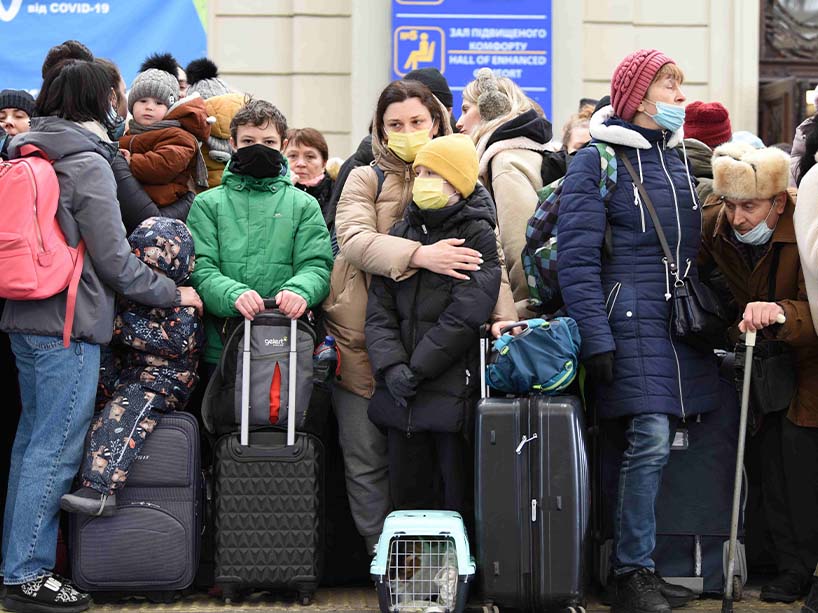Navigate misinformation about the war in Ukraine with the Social Media Lab's dashboard

Anatoliy Gruzd, Canada Research Chair in Privacy Preserving Digital Technologies and researcher at Ryerson’s Social Media Lab and Philip Mai, a fellow researcher at the lab, wanted to provide a dashboard to users trying to navigate misinformation about the war in Ukraine.
One thing Anatoliy Gruzd, Canada Research Chair in Privacy Preserving Digital Technologies and Philip Mai, a fellow researcher at Ryerson’s Social Media Lab, know quite a bit about is how quickly misinformation can proliferate on social media, and the dangerous real world implications it can have.
Gruzd and Mai worked extensively over the pandemic to dispel myths around COVID-19, but when Russia invaded Ukraine on February 24, 2022, the matter was personal to Gruzd. “I'm from Ukraine and my family's still in Ukraine,” he says. “As I was following news and discussions on social media about the war, I saw that a lot of content was either unverified or outright incorrect.” He and his collaborator Mai immediately set to work to create a tool to dispel some of the misinformation he was seeing.
Working together, in less than 24 hours, they built and launched the Conflict Misinformation Dashboard (external link) that provides necessary context and evaluations of disputed information around images and news on the Russian invasion of Ukraine. It clarifies content like the viral videos that claimed to show Russian and Ukrainian fighter pilots engaged in combat. They were in fact screenshots from video games, or images that are being reused from the war in Syria.
Since the dashboard launched on February 26, 2022, it has tracked more than 589 stories and counting. The dashboard automatically aggregates and translates professionally fact-checked claims about Russia’s invasion of Ukraine from around the web and offers it all in one place. The dashboard is available in English, Ukrainian and Russian.
“The goal is to show the public what kind of false and misleading claims are circulating across various channels related to the war, in an effort to help people develop some literacy skills to recognize when content lacks context, is misleading or downright false,” says Gruzd.
“Especially in times of war, people need to be equipped with accurate and timely information so they can make judgments and decisions on how to protect themselves and their family,” he says. “And if images that claim to show American soldiers paradropped into Ukraine are perceived to be true, it can easily turn what is currently a regional conflict into a worldwide conflict.”
How users can interact with the dashboard
The dashboard relies on a service provided by Google that collects the factual claims from over 100 different fact-checking organizations. “We use our own automated scripts to retrieve, organize, translate and visualize all of those verified claims that come in from the different fact checkers,” says Gruzd. “During the retrieval process, we specifically focus on those claims pertaining to Ukraine.” Right now on the dashboard, there are about 55 different fact-checking organizations that fact-checked relevant claims since the beginning of the conflict.
The dashboard allows users to refine their searches by specific fact checkers, dates or even outlets.
Navigating the fog of war
In times of conflict, navigating the fog of war to get accurate and timely information is critical for everyone from the average citizen to key policy makers. According to Gruzd, social media is being weaponized by different actors to drive and promote their own narratives around the conflict, and this means that as consumers of information, we need to be vigilant so as not to share more misinformation. “While social media does help us to stay up to date with the events in Ukraine, it does also introduce a lot of noise.”
To provide more context to the uninitiated user, Gruzd says the lab has also included additional resources including background information and embedded tweets with tips on navigating social media. The dashboard also provides resources like the video below, that shows people how to do a reverse image search.
For the pandemic, the lab also created three fact-checking tutorials (external link) that Gruzd says users could run through and apply the same principles to news around this war.
Some quick notes on how to be careful with what you read and share right now on the Russian invasion of Ukraine, based on SIFT, with some slight shifts in emphasis for fast-moving foreign events. 🧵 pic.twitter.com/ksID1mFB67
— Mike Caulfield (@holden) February 24, 2022
Gruzd says, at the minimum, he hopes the dashboard better informs the public and forces people to stop and think before they share. “If it leaves people with the idea that maybe they should double-check something or not share something right away, that would be one of the positive outcomes of this project.”
To use the Conflict Misinformation Dashboard, visit the Social Media Lab’s website (external link) .